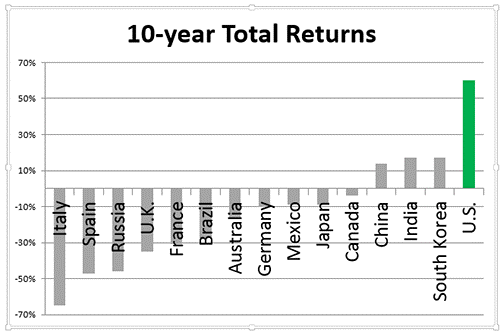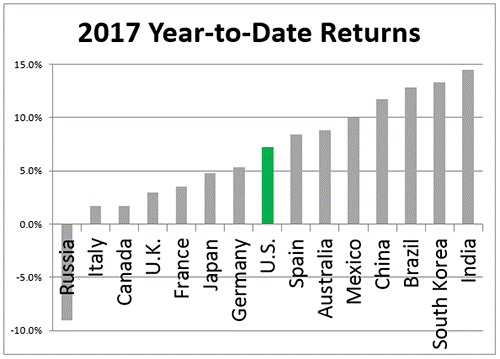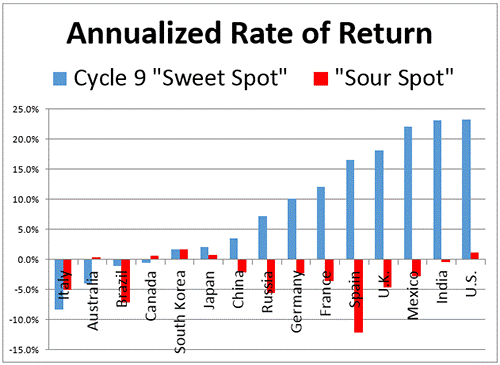Harry S. Dent Jr.'s Blog, page 87
March 27, 2017
It’s Time to Shatter the Stones
[image error]I’m sorry, but I don’t have a healthcare problem.
I have a concierge doctor at a fixed annual fee, with free visits and discounts on blood tests and other things I need. On top of that, I have a high–deductible insurance policy that only covers unexpected costs over $6,000, like if I have a heart attack or something.
I’m accountable, which means I feel the expenses for my healthcare day to day, week to week, and month to month. I pay for my visits and expenses with a credit card linked to my HSA account. There’s no bureaucracy, there’s no paperwork, and there’s no confusion over what’s covered or not under the typical plan.
And there’s no illusion that healthcare is free after I’ve paid my premium!
As a result, I don’t go to the doctor just for anything… just because it’s covered on my healthcare plan! Millions of others do, though. Why wouldn’t healthcare costs be spiraling out of control when people have no incentive to monitor and control their costs?
And then doctors have to cover their asses against endless lawsuits, so they over-test and over-diagnose everything… What the hell?! Why should people win the lottery when doctors make a one-out-of-a-thousand mistake?
There’s a reason our healthcare costs about twice as much as it does in other developed countries…
Our system is full of B.S. special interests and insurance bureaucracy that adds layers and layers of costs!
Every step of this chain of special interests is locked in by decades of lobbying efforts.
Insurance companies are NOT in the insurance business. They’re in the bureaucracy business, charging for endless paperwork in what should be a straightforward, pay-for-service-as-needed industry.
But a new trend – some light amid otherwise endless darkness – may just be winning out in this nightmare of special interests and bureaucracy…
The new “truth” is direct primary care, where people pay a monthly fee for doctors that give them more attention at a fixed and predictable cost – like $50 to $100 a month. There’s also a higher level of service – concierge medicine, where you may pay $200-plus per household a month.
Like I said, that’s what I have. It’s well worth it because I get visits whenever I need them, and, more importantly, I enjoy preferred access to specialists like cardiologists and internists when I need them.
My primary-care doctor is more accountable to fewer patients and has a more predictable revenue stream. My high-deductible insurance plan is exactly that: my insurance against the unpredictable.
Then there’s Obamacare…
What idiot couldn’t figure out that if you suddenly added tens of millions of new people to a system with near-term fixed professional skills and healthcare facilities you’d see costs skyrocket?!
It’s Econ 101 stuff: supply and demand! Or in this case, inelastic demand.
There’s no market with less rationality and greater cost disincentives than our very own U.S. healthcare system.
And there’s no way to fix this perverted, special-interest-driven system. It needs to break down and be re-created from the bottom up… period!
That starts with consumer-driven, direct primary care systems that make both doctors and consumers accountable for real service. Insurance is only for the more extreme scenarios, and so it doesn’t add endless bureaucracy to the system… not to mention endless incentives to go for the “all you can eat buffet.”
Insurance companies will, of course, hate this plan. How would they make as much money without their inherent bureaucratic B.S.?!
I didn’t set out to organize my healthcare the way I did, but many others do. We just did the logical thing.
We’re the revolution.
And it’s going to take a revolution to change this overly bureaucratic and complicated industry, where every special interest has carved their fees, costs, and B.S. into stone.
It’s time to shatter those stones.

Harry
Follow me on Twitter @harrydentjr

The post It’s Time to Shatter the Stones appeared first on Economy and Markets.
March 24, 2017
Are You Listening?
 The past week was full of Federal Reserve speeches, which, yeah, I wouldn’t blame you one bit if you tuned them out completely.
The past week was full of Federal Reserve speeches, which, yeah, I wouldn’t blame you one bit if you tuned them out completely.
But I listen to what they say, though not because I’m a masochist. Staying on top of the Fed is my bread and butter, after all. Keeping up with the Fed’s various statements – especially Fed Chair Janet Yellen – filtering out the noise from the actual substance helps me answer the most important question for the markets and my readers: what’s the Fed’s agenda?
After the rate hike last December, the markets didn’t expect the Fed to hike rates until June at the earliest. But the markets learn and adapt quickly (far quicker than the Fed!) and so by the time the Fed announced a rate hike last week, the markets already priced in a 100% likelihood of that happening. How did that happen?
I wrote earlier this month (just before the rate hike, in fact) that “one of the most effective policy tools of the Fed is talking. In the name of being transparent, the Fed believes it can move interest rates in one direction or another by just talking […]Over the last few weeks, a number of Fed officials said a rate hike is likely on March 15. And it’s not just the officials who are usually more prone to hike (we call them hawkish), but also a few that usually are more cautious (dovish) have chimed in that it’s time for a hike.”
So, what was their agenda? When Fed officials speak they always have an agenda; it could be dry and academic, or maybe a third party wants their individual opinion and expertise. But when you hear a coordinated message from a number of officials in a short period of time, it’s part of an agenda to change the mindset of the markets. Take a look at what that looks like below:
 Yields spiked from well below 3% when the market didn’t believe a rate hike was coming anytime soon to just over 3.20% at the peak before the hike.
Yields spiked from well below 3% when the market didn’t believe a rate hike was coming anytime soon to just over 3.20% at the peak before the hike.
I guess you could say the Fed did a good job preparing the markets for their quarter-point hike! But what’s happened since? Well, take a look below:
As you can see, yields fell back to where they were before all the Fed talk. But to be fair, the Fed controls the federal funds rate – in other words, the overnight rate the Fed charges to member banks to meet reserve requirements, and not the long-term rate above.
Of course, the Fed prefers to control the entire yield curve, but it has its limits. Its policy tool of increasing the overnight rate seems to have had less impact on the market than its other favorite tool… talk.
This week, there were more than a dozen scheduled Fed talks and as I’m writing, six have spoken about one thing or another. Their audiences include a group of university economics students, women in housing and finance, and even the Bank of England.
But I don’t see another coordinated event to move the markets and it’s unlikely they will use that tool for a while… the next Fed policy meeting isn’t until early May.
What’s good for us is that market volatility has risen with Fed action and talk, and that means more trades for Treasury Profits Accelerator readers – up or down, we make money when the Treasury bond markets overreact! Talk is cheap, so the saying goes, but volatility sure isn’t.
Good investing,

Lance Gaitan
Editor, Treasury Profits Accelerator

The post Are You Listening? appeared first on Economy and Markets.
March 23, 2017
American Kids Can Do More than Sing and Dunk
 I like music, but it’s probably more accurate to say that I like songs. The difference is obvious when my wife and I roll down the street listening to the radio.
I like music, but it’s probably more accurate to say that I like songs. The difference is obvious when my wife and I roll down the street listening to the radio.
I’ll hum the tune and, quite badly, sing the words. My wife, on the other hand, is just as likely to make fun of the simple chord progression or repetitive notes as she is to join in the chorus. She’s musically inclined, and hears a lot more of what’s going on in the background than I ever will.
I think it’s awesome. The world needs people with all kinds of talent.
But judging from current television offerings, you’d think the world has two success tracks: singing and sports. (Right now, for instance, college basketball is all over TV.) I think we need more than that for our country to flourish.
The experience in my household, with my kids, illustrates my concern about this.
My older daughter is the middle child. She’s definitely bright, but she’s also clever. One day after pre-K I asked her about her day. She wasn’t interested in talking, so she said it was secret.
I told her that I wouldn’t share it with anyone, so I would keep it a secret, which I thought was a witty answer. She replied that if she didn’t tell me at all, it would still be secret. I knew I’d have to watch this one closely.
As she grew up, she started crafting, making wallets out of duct tape (a real thing with 11-year- old girls), and putting burn marks in her bedroom floor with a glue gun as she built stuff. She also did well in school, eventually earning the physics award at her high school.
Then came the question. What to do with all of this talent?
Her guidance counselors gave her the old, “What do you want to do?” speech, and guided her toward prestigious universities.
I tried to help, but, coming from the business world, my knowledge of careers where people make stuff is fairly limited. She interned at a friend’s engineering and architectural firm, and decided that mechanical engineering was the way to go.
Six weeks into her freshman year at Georgia Tech, she called to let me know she’d found the perfect major – Industrial Design.
“Great! What do they do?” I said.
The basic answer: An engineer develops how cell phones communicate, but an industrial designer develops the physical unit.
It’s been a perfect fit. I applaud Georgia Tech for helping her change majors and catch up with her classmates.
She and her peers tackle real-world problems, designing and building prototypes of solutions almost every semester.
Last week, she and a teammate competed in the final round of “Inventure,” which the college kids call “American Idol for Nerds.”
The contest pits hundreds of college student inventors against each other and the field is progressively narrowed to six finalists. The winners got $20,000 and the university files a patent on their behalf. Second prize is $10,000 and a patent. She didn’t win, but it was thrilling to be there for the competition!
It was televised… on Georgia Public Television. Which gets back to my concern. We are hiding such careers and majors in plain sight, even though communication is cheap and video is easy.
With three kids in the house for the last 24 years, we’ve seen a lot of television. During that time, reality TV came into its own. Television programmers realized they could get millions of viewers without paying actors. Instead, they could have people actually compete to be on the shows. And yet, advertisers would still pay big bucks to sponsor the programming.
What a windfall!
With just a few celebrity judges, you can have thousands of people pour their hearts out on stage, looking for their big break. Think American Idol, The Voice, America’s Got Talent, etc.
At the same time, there’s always been sports on television, with ever-bigger contracts for players, as well as the standard fare of fiction thrown in.
I love sports, and I enjoy music. I’m glad we have both and that many young people aspire to those professions. But precious few people will earn a living in either of these areas, and thank goodness for that!
We need doctors, lawyers, accountants, bricklayers, carpenters, phlebotomists, police officers, writers, industrial designers, or guys like my colleagues Harry, Adam, Charles, Lance, and John, and a host of others to not only keep this country running, but to help us flourish in the years to come.
With the ability to shoot video on our phones, and television programming exploding through streaming services, why don’t we have shows dedicated to what is possible for the next generation, whether through competition or simply exploration, beyond playing fields and microphones?
On broadcast television, maybe the bar is too high. Program directors need shows that will attract five to 10 million viewers, and it’s hard to see where “Cool Careers” would draw such a crowd.
But streaming services are a different story. Making programs available this way is cheap. If the cost of production were equally cheap, then perhaps such a show would be worth the modest investment for Netflix, AppleTV, or even Amazon Prime.
The goal would be simple – expose kids to a host of opportunities that they’ve never heard of, but are vital to the health and growth of the nation, and then explain the path through either apprenticeships, vocational training, or college.
We’re great at telling kids they can be anything they want to be. We need to do a better job of giving them ideas as to what is possible.

Rodney
Follow me on Twitter @RJHSDent

The post American Kids Can Do More than Sing and Dunk appeared first on Economy and Markets.
March 22, 2017
Home-Country Bias Part II
 Last week, I introduced you to the concept of home-country bias – a phenomenon that routinely leads investors to over-allocate to domestic stocks.
Last week, I introduced you to the concept of home-country bias – a phenomenon that routinely leads investors to over-allocate to domestic stocks.
Americans prefer to invest in U.S. stocks because, psychologically, it feels like the right thing to do.
But it’s not!
U.S. stocks outperform foreign stocks only half the time, roughly. So, following the logic, a portfolio that is always concentrated in U.S. stocks is guaranteed to underperform about half the time.
My message last week was a stern warning aimed at U.S. investors.
Don’t get complacent!
Don’t extrapolate the past into the future… assuming U.S. stocks will outperform for the next 10 years, just because they have for the last 10 years.
Take a look at this chart, which shows 10-year total returns of the top 15 global economies.
 Anything jump out at you?
Anything jump out at you?
U.S. stocks have trounced foreign markets for the last decade. We know this.
Now, take a look at this chart, which shows 2017 year-to-date returns…
What jumps out at you this time?
Anyone who assumed U.S. stocks would outperform in 2017 has so far been disappointed. A number of foreign stock markets have proven to be better bets.
But again, buying foreign stocks is something most investors don’t feel comfortable doing. Tying up your hard-earned capital in foreign stock plays feels riskier. But in reality, it isn’t.
You see, I’m not a proponent of buying foreign stocks and holding them indefinitely.
Instead, I use a forward-looking algorithm to identify pockets of outperformance opportunity in foreign stock markets – “sweet spots,” if you will.
I use the Cycle 9 Alert system that I developed over five years ago.
To truly understand the power of these foreign market “sweet spots,” I’ve run some analysis that shows the annualized return of foreign markets.
I looked at the annualized return of foreign stocks while in a Cycle 9 “sweet spot.” And I’ve compared that to their annualized return the rest of the time – we’ll call it their “sour spot.”
The evidence is convincing. Take a look…
As you can see, foreign stock markets perform significantly better during Cycle 9 sweet spots… and much worse the rest of the time.
The average annualized “sweet spot” return comes in at a healthy 8.4%. Whereas the average “sour spot” return is negative 2.7%. And this leads to an average outperformance of 11% per year.
Of course, these foreign market “sweet spots” are so powerful that they only come about occasionally – less than once a year, on average. And they only last a short period of time – around three months.
All told, my Cycle 9 Alert algorithm gives us the chance to make highly-targeted and highly-profitable bets on foreign markets – but only when the time is right.
By investing in foreign stock markets just 19% of the time – only during their sweet spots – we can, essentially, turn negative investor returns into positive trader returns.
One example of this strategy in action is my recent recommendation to buy European stocks.
On March 7, I told my Cycle 9 Alert readers to buy a specific investment, related to European stocks.
Since then, European stocks are up 3.5% in just two weeks (145% annualized)… while the Dow Jones Industrial Average is down about 1%.
The specific investment I recommended has already gained more than 25% in less than 15 days. And I’m expecting bigger profits to come our way over the next two to three months – so there’s still time to act on this foreign market opportunity.
Whatever you do – don’t be lazy… and don’t call it “patriotism.” Buying U.S. stocks may feel comfortable, but ignoring foreign market opportunities nearly guarantees you’ll trail the pack half the time.

Adam O’Dell
Editor, Cycle 9 Alert
Follow me on Twitter @InvestWithAdam

The post Home-Country Bias Part II appeared first on Economy and Markets.
March 21, 2017
This is Not Just About Trump and Brexit
[image error]I’ve been writing a lot about what I see as the mega trend right now… and what will make this economic winter season different from the 1930s.
We’re not just seeing a classic debt and financial asset bubble that will unravel into a deflationary depression, as occurred in the 1930s and many times throughout history.
We’re not just seeing a populist revolution, as we saw with Hitler and Mussolini in the 1930s and World War II, and as has occurred about every 84 years throughout history.
We ARE seeing the early stages of a major 250-year cultural, political and social revolution that revolves around religious values and political splits around the world… and it results in massive economic gains decades after.
The last such major revolution hit in the late 1700s when democracy and free market capitalism converged. That revolution set the stage for the greatest surge in affluence and globalization in history, especially from the mid-1800s forward.
Technologies further accelerated globalization and urbanization, especially since World War II. This has caused a growing divide in incomes and wealth, as well as in cultural, religious and social values, within countries and between major global regions.
One of my favorite and paradoxical principles of growth and evolution is this…
Technologies change faster than cultures, and cultures change faster than genes. This is the reason that any extended periods of strong growth and progress will create growing divergences in incomes and values that eventually become unsustainable at some point.
The typical developed country has six times the GDP per capita of the typical emerging country. At the more the extremes, it’s like 30 times. Southern and East European countries have as little as half the GDP per capita of North and Western Europe.
Globalization has succeeded so much that it has put very different cultures and income groups in each other’s face.
And we’ve had enough of it… particularly those who find themselves on the lower rungs.
It’s now clear to me that globalization has peaked for years, if not decades, to come and we’re going to have to regroup around regions and countries with common cultural and religious values before we can globalize again in a new, more bottoms-up network economy.
The best global graph of the major different cultures comes from The Global Values Survey out of a recent article by Will Wilkinson. This shows nine distinct global cultures around two variables that I find very meaningful. On the x axis is survival (conformist) versus self-expression (individualistic) values. On the y axis is traditional (faith) versus secular-rational (scientific) values.
Take a look at this…
 If you go from the bottom left of the chart to the upper right, you’re going from less progressive and affluent to more progressive and affluent. From the upper left down to the lower right, you see the best representation of the blue/red – aka progressive/conservative – divide globally (the line I added to this chart shows this clearly).
If you go from the bottom left of the chart to the upper right, you’re going from less progressive and affluent to more progressive and affluent. From the upper left down to the lower right, you see the best representation of the blue/red – aka progressive/conservative – divide globally (the line I added to this chart shows this clearly).
The two groups that are the most rational and self-expressive are Protestant Europe and the English Speaking (often called the British offshoots).
Catholic Europe and Confucian East Asia are more on the rational side but less self-expressive.
The least progressive on both values is the African-Islamic group.
The East Europe/Russian Orthodox are more rational but low on self-expression.
Latin America is more traditional but more expressive.
You can see here why there is such a clash between the more affluent Christian cultures of Europe and the English-Speaking groups versus the African-Islamic ones. They’re quite literally on the extreme opposite sides on both value dimensions.
You can also see why Russia and the Eastern European Orthodox countries don’t get along with Western Europe and North America.
It’s noteworthy that there isn’t the same clash with Latin America, despite it being more traditional, because they’re largely Christian and are closer on the self-expressive scale.
Also note the borderline countries in that blue/red split: Montenegro, Macedonia, Vietnam, Thailand, South Africa, Chile, Argentina and Poland. With further urbanization and wealth, these could cross over to the more progressive or blue side.
This breakdown of the current situation helps us see what things might look like in the years and decades to come. Think about more effective trading and political zones. Europe could break into the more north/south divide between Protestant (more affluent and competitive) and Catholic. We could have two euros and maybe two Eurozones.
Now that Britain has left the union, why shouldn’t there be a stronger alliance between Great Britain, Scotland, Ireland, the U.S., Canada, Australia and New Zealand? These are highly compatible cultures with similar religions, lifestyles and language.
The Asian Tiger countries – Japan, South Korea, Taiwan, Singapore, Hong Kong and Coastal China – would make a great trade zone and alliance.
Southeast Asia could be a separate zone and possibly ally with India and the interior of China to make up a trade and political block with the biggest population in the world.
Putin’s desire to re-unite the Soviet Union could work, but only if the Orthodox countries remained sovereign and independent while forming a trading union like the Eurozone.
The dominant Sunni nations of the African-Islamic group could be a major alliance with the smaller and more concentrated Sunni dominant countries or regions allying around Iran in the central Mid-East.
And of course, Latin America makes sense as a more integrated political trading block with common religion and language.
The trick is to first “break back down” into more coherent nations and let countries re-align around their progressive/conservative (blue/red) divisions… redrawing nationalistic borders and political policies so there’s more unity and common values in each sovereign entity. Only then can we build back up to greater growth and global integration again.
Maybe we need two to four U.S. regions, two blue and two red, with most states maintaining their political structures.
Iraq and Syria definitely need to redraw around Sunni, Shia and Kurd regions. The Kurds could go with Southern Turkey, the Shias with Iran, the Sunnis then take over the rest of Iraq and Syria.
This is going to be the major trend in coming years. And it will lay the groundwork for another mega global boom later in this century… but we can’t get there from here yet!
More to come on this deep and critical subject. Stay tuned.

Harry
Follow me on Twitter @harrydentjr

The post This is Not Just About Trump and Brexit appeared first on Economy and Markets.
March 20, 2017
The Rules of a Side Hustle
 I’m a big fan of using Uber in lieu of a traditional taxi when I travel, but I had a peculiar experience recently in Lima, Peru. If you’ve read some of my work before, you may know that my wife is from Peru.
I’m a big fan of using Uber in lieu of a traditional taxi when I travel, but I had a peculiar experience recently in Lima, Peru. If you’ve read some of my work before, you may know that my wife is from Peru.
It was hot that day, and I was headed to grab a drink overlooking the sea. I hailed a standard Uber X. (As Lance made abundantly clear a few weeks ago, I have a well-deserved reputation as a tightwad, and I would never spring for Uber Black.) But what greeted me curbside was not the usually well-used Toyota or Kia I would expect to see in Lima.
No, it was brand-spanking-new Audi A6.
The gentleman driving the car was well-dressed and well-mannered. But I’ll never know whether it was a bored rich guy looking to kill a little time or a rogue chauffer making a little side money with the boss’s car.
I’m thinking it’s more likely the latter.
Wages are low in Peru, so it’s not unusual to see working- and middle-class people juggling multiple side jobs. But what’s more interesting to me is that this is also becoming more and more common in America, particularly among Millennials.
A lot of this is by necessity.
Wages haven’t budged much over the past 20 years, even as housing costs have ballooned. And it doesn’t help that the Millennials have the highest student loan balances of any generation in history. For a lot of people, getting ahead means working longer hours than they used to.
But necessity and cash-strapped Millennials aren’t the only things driving the rise of the side hustle.… I’ve seen plenty of graying baby boomers getting into the entrepreneurial spirit with their free time as well.
It’s never been easier or cheaper to have a side business, nor has it ever been more potentially scalable. A viable webpage (with an online payment system included) can be thrown together in a couple hours for almost nothing. And simple mobile apps like Uber or Airbnb allow you to monetize your car or home for extra income.
I’m not going to tell you what to choose for your next side hustle. The options are limitless. For crying out loud, my cousin’s friend from high school became a millionaire playing video games and posting the videos, with commentary, on YouTube.
If that worthless bum can find a lucrative side business, then so can you or I.
You’ll have to figure out your own side hustle, and what works best for you. But today I’m going to tell you what you can do with your income once you have the cash flowing in.
My advice is to take a play out of my friend David’s book. I recently wrote that David is retiring at 40… based primarily on the income his rental properties generate. But having the ability to kick his feet up when most of us, well, aren’t, was only made possible because he didn’t spend the income his properties were bringing in. Instead, he lived off the salary from his day job and used his side profits to pay down his mortgages faster.
If you want a higher-profile example, consider Jay Leno, the former host of the Tonight Show. In Leno’s own words, “When I was a kid, I always had two jobs, and I would bank one, and I’d spend the other. Then, when I got The Tonight Show, I just continued doing that.”
Leno lived off of the income from his other comedy gigs and treated his entire multi-million-dollar salary from The Tonight Show as if it were a giant 401(k) plan, never spending a cent.
Now, realistically, most of us will never make the kind of money that Leno did in his prime. But we can still follow his lead.
If you have side income – be it from a second job, freelance work, rental properties or anything else under the sun – live off of your day-job salary and put every dollar you earn from your side hustle directly into savings.
If you play your cards right, you can shelter a good bit of that income via a Solo 401(k) or SEP IRA. But in any event, you still need to actually do something with the money once you’ve saved it. You could put the money in the bank, but even after last week’s Fed rate hike you’re not likely to earn even a full percent in a CD or savings account.
If you want a yield worth having, you’ll have to look elsewhere. And on that front, I have you covered. It’s why I write Peak Income, a newsletter dedicated to looking for income opportunities that are a little off the beaten path. The 19 recommendations in my model portfolio sport an average yield of nearly 8%.
That’s side hustle worthy money!

Charles Sizemore
Editor, Peak Investor

The post The Rules of a Side Hustle appeared first on Economy and Markets.
March 17, 2017
Why Income Matters
 If you’ve read my work for a while, you know that I have a lot of respect for my grandfather. He’s actually the reason I got into the financial world.
If you’ve read my work for a while, you know that I have a lot of respect for my grandfather. He’s actually the reason I got into the financial world.
He wasn’t a stockbroker or a portfolio manager. In fact, as the owner of an auto supply store in Fort Smith, Arkansas, he was about as far removed from Wall Street as you could get.
But he was a savvy investor who knew a thing or two about the importance of income.
Apart from his dividend-paying stocks and his bonds, he also owned a small warehouse that threw off rental income. The key was that his income sources were diverse, which gave him protection in the event that one of his stocks or bonds blew up.
My grandfather never actually retired – he was the entrepreneurial sort who preferred to die with his boots on – but the income streams he put together supported my grandmother for more than a decade after he was gone. They could have easily continued to do so for decades more.
My grandfather also had his own version of Peter Lynch’s mantra of “buying what you know.” Lynch, the former manager of the Fidelity Magellan fund and the most successful retail mutual fund manager in history, was known to troll the malls looking for investment ideas.
Well, in my grandfather’s version of “buying what you know,” he liked to invest in local Arkansas companies. He liked the idea of physically being able to keep an eye on his investments, and he reasoned that he’d be better able to understand a company in his backyard than one hundreds or thousands of miles away.
It just so happened that a little retailer you might have heard of – Walmart – was a local Arkansas company, headquartered about an hour and a half from Fort Smith.
My grandfather believed in the company and was an early investor.
And when the shares exploded in the decades that followed, he rode it all the way up.
In Lynch’s words, my grandfather nabbed a “10-bagger,” making over 10 times his money on that investment.
Here’s the thing: Walmart made him a boatload of money, but he had no way of knowing that would happen when he originally bought it. And he certainly wasn’t banking on it supporting him or my grandmother in retirement. Had he lived longer, he might have sold some of it to rebalance or to splurge on some of life’s little indulgences.
But it was never his plan to live off of his capital gains because those can evaporate in a heartbeat.
This is exactly why I write my own income-based newsletter, and why I recently brought these beliefs to bear in this special video presentation.
Just like my personal approach, my goal is to help you meet that basic baseline of income you need to fund your retirement. Don’t get me wrong, I like scoring big with capital gains as much as the next guy.
In our model portfolio, we have several positions that have given us bigger price returns than income returns thus far, but capital gains definitely come second to my recommended low-risk, but automatic income-producing funds. The 19 funds in my portfolio have an average yield of just shy of 8%.
First and foremost, I want to help pad your income every month, just like my grandfather taught me. Click here to learn more about how to do it.

Charles Sizemore
Editor, Peak Investor

The post Why Income Matters appeared first on Economy and Markets.
March 16, 2017
Don’t Fall Victim to Home Country Bias
 Call it patriotic… call it lazy… but most people stick close to home when it comes to investing.
Call it patriotic… call it lazy… but most people stick close to home when it comes to investing.
This so-called home country bias is a phenomenon too big to ignore.
It’s pervasive across time and geography. And even though it makes investors feel all warm and fuzzy inside, it generally tricks us into accepting lower returns and higher volatility from domestically-tilted portfolios.
But my message today is a warning targeted squarely to U.S. investors…
U.S. stocks have trounced foreign stocks for years now.
Whether you look back to October 2007, including the Great Financial Crisis… or from March 2009 onward, capturing just the recovery… U.S. markets have been the best game in town for nearly a decade.
Take a look…
Here are total returns from October 2007 to present…
And here’s how the U.S. did from March 2009 to present…
 As you can see, if you’re a U.S. investor who over-allocated to U.S. stocks over the last 10 years… well, you look like a genius! A filthy-rich genius!
As you can see, if you’re a U.S. investor who over-allocated to U.S. stocks over the last 10 years… well, you look like a genius! A filthy-rich genius!
But you shouldn’t expect your good fortune to continue forever!
You see, just because U.S. stocks have outperformed for the past decade does not mean they have always outperformed… nor that they will always outperform.
In fact, the outperformance of U.S. stocks, over non-U.S. stocks, in general, is very cyclical. Take a look at this chart from Vanguard…
 Going back to 1970, you can see how the outperformance of U.S. stocks waxes and wanes over time.
Going back to 1970, you can see how the outperformance of U.S. stocks waxes and wanes over time.
Sometimes U.S. stocks lead the pack. Sometimes foreign stocks are out front.
Sometimes U.S. stocks become overvalued, relative to foreign stocks, and vice versa.
Sometimes “sentiment” leans toward the U.S…. other times toward foreign markets.
Regardless the specific drivers of these cycles, the mean-reversion nature of outperformance is exactly what we should expect from a capitalist, global economy. Competition keeps the winners in check, over the long run.
But it also represents a dangerous blind spot for investors who have ridden the high of a home-country-bias advantage a little too long.
I’m talking to you, U.S. investors!
It’s easy to get lulled into thinking U.S. stocks will always outperform – particularly after a good, long run… and especially after a decade of outperformance! But as the chart above shows, over-allocating to U.S. stocks is not the best strategy all the time.
Of course, it’s a significant challenge to precisely time the tops and bottoms of the U.S./foreign outperformance cycles. And many advisors would simply suggest building a diversified buy-and-hold portfolio, with appropriately-sized allocations to many markets – U.S. and foreign.
I prefer I more dynamic approach – one that involves adding foreign market exposure for just a few months at a time… only when specific foreign markets are highly-likely to outperform U.S. stocks.
And I use my Cycle 9 Alert algorithm to identify those foreign market “sweet spots,” which can sometimes last for just a few months at a time.
Right now, European stocks are in one of those sweet spots.
Despite facing three significant elections this year – and, in the long-term, worse demographic trends than the U.S – investors have recently been ramping up their buying of euro zone stocks.
In fact, I recommended a specific “bullish Europe” play to my Cycle 9 readers just a couple of weeks ago. And since then, European stocks have beaten the S&P 500 three to one.
We’re sitting on an open profit of more than 30%. But I expect that to grow even larger, since we’re only two weeks into our targeted two- to three-month holding period.
I can’t say for sure whether European stocks will outperform U.S. stocks over the next 10 years – reverting the United States’ recent, decade-long run.
But I do know that investors who are blind to home country bias… those who are always over-allocated to U.S. stocks… will someday be sorely disappointed.
And I know that investors who stay flexible… those cunning enough to bet on foreign markets when the time is right – as it is NOW – will be nicely rewarded.
No matter what you do – don’t get lulled into thinking your domestic market is always the best game in town. Half the time, it’s not!

Adam O’Dell
Editor, Cycle 9 Alert
Follow me on Twitter @InvestWithAdam

The post Don’t Fall Victim to Home Country Bias appeared first on Economy and Markets.
March 15, 2017
Who Knew Drop Protection Could Pay So Well?
 The telephone is one classic example. The fax machine, helium, and gasoline are others. Even the Internet’s usefulness was underestimated when it was first developed.
The telephone is one classic example. The fax machine, helium, and gasoline are others. Even the Internet’s usefulness was underestimated when it was first developed.
Such advances happened on a nearly unimaginable scale for one innovator that just happened to be based near where I grew up. Back then it was far from any city, yet it attracted the top scientists and drew engineering talent from two top schools just hours away. Today, it employs about 40,000 people around the globe.
In the 1960s, it invented a tougher automobile windshield that limited injury by shattering into small particles when smashed. But this was 1970, a time when there were no mandatory safety requirements, so it wasn’t cost-effective for carmakers. Thus, the technology was shelved
And it languished, forgotten, until a phone call 35 years later.
That’s when Apple’s legendary Steve Jobs called the company’s CEO out of the blue. Jobs wanted the company’s glass for a new product. “Oh, and I want as much as you can pump out in half a year.”
Just one problem: It wasn’t making any and hadn’t since 1971!
The company’s CEO was told not to worry – it was possible. As the CEO recounts, “We did it in under six months. We produced a glass that had never been made.” The first iPhone, released in June 2007, contained the “new” product, and the rest is history.
As I’m sure you know, our phones take daily beatings. Prolonging their life is serious business. This company’s glass technology is so good a shield that Apple competitors like Samsung, Motorola, and HTC now use it to safeguard their products from drops, scratches, and spills as well.
Drop protection, in particular is still the number-one request from consumers, and I’ve heard that you can drop an iPhone from heights four times as high as competitive glass designs without destroying it. Of course, no one plans that kind of a drop, but when it happens, you’re glad you’ve got the strongest stuff around.
So, in 10 years, this specialized glass went from an unrealized idea to a crucial component in 4.5 billion devices – smartphones, tablets, and computers – around the world. And the maker has Apple to thank!
The company I’m talking about is the newest recommendation in my research service Hidden Profits, which, as the name implies, digs into the numbers behind the headlines and find unheralded profit opportunities. Turns out that high-end glass is actually a better business than selling the phone itself. Gross profit margins for the glass’s maker were a fat 43% in the fourth quarter (versus 38% for Apple and less for other phone makers).
This is far from the only change-making innovation from this high-tech outfit. It invented optical fiber in 1970 and is now the largest manufacturer of this critical communications material in the world. (If you didn’t know, optical fiber is made of glass.)
Every year, the company plows about 10% of its sales back into research and development to drive more innovation and protect those juicy margins. Last year, it committed $10 billion in growth opportunities through 2019.
It’s hardly alone in that sense. Many high-tech companies must reinvest aggressively in innovation to keep their products on the cutting edge. Unfortunately, their shareholders get paid last and must rely (or hope) for stock price appreciation to deliver gains.
But not our newest recommendation to the model Hidden Profits portfolio.
This pick has so much spare capital it can fund cutting-edge research and cut us plenty of cash, too. Ultimately, it pays its investors first – and you should be one of them. Find out more here.
Good investing,

John Del Vecchio
Editor, Hidden Profits

The post Who Knew Drop Protection Could Pay So Well? appeared first on Economy and Markets.
March 14, 2017
The Red States Have Had Their Say… Now It’s the Blue States’ Turn
[image error]We’ve not seen this level of political polarization since the Civil War. And it’s not unique to the U.S. It’s happening around the world… a backlash against globalization.
The red states scored a massive victory when President Donald Trump won against the odds. Six states switched from borderline blue to borderline red during that election.
But history has insights for us about such a revolution. For starters, they don’t tend to end where they started. Despite being a clear play of opposites, like conservative and liberal, history favors the progressive side. Over the longer term, the trends are only in one direction: toward increased affluence, greater freedom, more trade, and deeper political and social tolerance.
The south or red states had the momentum in the early part of the Civil War, but lost in the end. The nation moved in the progressive direction and became more unified than ever. While the south had more conviction and cause, the north had more people, technology and affluence… and were on the right side of the longer-term trends.
What’s clear in the early stages of this latest revolution is that globalization has peaked, and likely for decades. We’re going to have to regroup politically around common and regional cultural and religious values before we can globalize and progress again.
But let’s see what happens when the blue states have their say – as they again have the edge in economic power. California is threatening to go to ballot in 2018 to secede from the union. The red states may have won round one of this civil war, but it’s just getting started.
A political and social reformation the magnitude of the American Revolution is in motion and will take several years to begin to resolve. Get all the details on the “Yes California” campaign, see what’s brought us to the point of this revolutionary movement and get a look into the historic shift ahead of the curve in our latest infographic below.

Harry
Follow me on Twitter @harrydentjr

The post The Red States Have Had Their Say… Now It’s the Blue States’ Turn appeared first on Economy and Markets.




